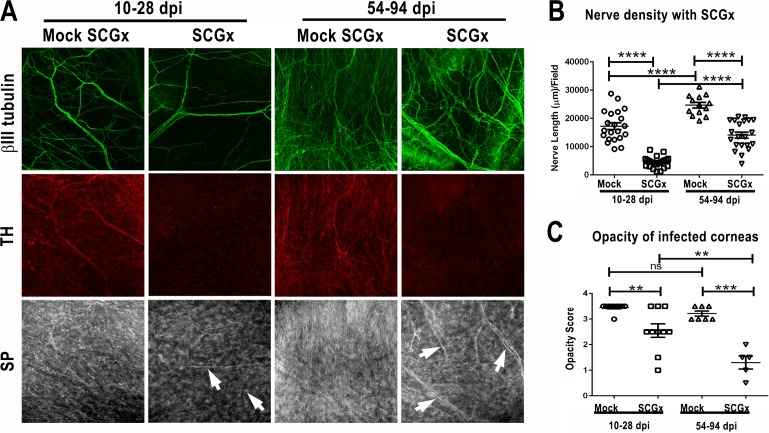Figure 3.
Superior cervical ganglionectomy eliminates sympathetic nerves, allows regrowth of sensory nerves, and prevents development of severe persistent HSK in BALB/c mice. BALB/c mice were infected with 1 × 105 pfu of the HSV-1 KOS strain. Groups of infected mice received mock SCGx or SCGx at 10 dpi and were followed to 28 dpi, whereas other groups received mock SCGx or SCGx at 54 dpi and were followed to 94 dpi. Opacity scores were recorded on the day mice were killed. Whole mounted corneas were stained for βIII tubulin (green), TH (red), and SP (gray). (A) Superior cervical ganglionectomy administered at 10 dpi effectively eliminated the hyperinnervation at 28 dpi and permitted regrowth of a low density of SP-positive sensory nerves. Administering SCGx after hyperinnervation when sympathetic nerves had established (54 dpi) did not eliminate the hyperinnervating fibers, but the nerves did not express the sympathetic nerve marker TH. Note the hyperinnervation of the corneal stroma of mice that received mock SCGx at 10 or 54 dpi, with nerve fibers that expressed the sympathetic nerve marker TH but not the sensory nerve marker SP. (B) Nerve density in corneal stromas of mock or SCGx-treated mice at 28 and 94 dpi was quantitated as the cumulative length of nerve fibers in 500 × 500-μm areas of the corneal stroma. (C) Opacity of infected corneas was recorded just prior to death at 28 and 94 dpi. **P < 0.01, ***P < 0.001, ****P < 0.0001.

